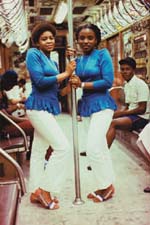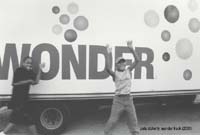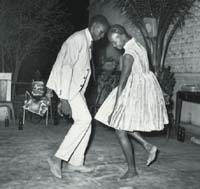
the wedge`s flava
By Saada Branker
On the evening that the Wedge Curatorial Projects held its book launch, scores of artists and people who love art poured into the Burroughs Building on Toronto’s Queen Street West, many oblivious to the fact they’d stepped right past one of the night’s featured artists while on their way inside. Just as well. At one point, Jamel Shabazz stood a few feet outside the entrance, not noticing them either.
The Brooklyn-based photographer and author of Back in the Day had focused his camera’s lens on one particular woman in bloom. She was pregnant and glowing in an emerald summer dress, her soft brown afro a symbol of the night’s energy. Gingerly, Shabazz positioned her to stand in front of a neighbouring storefront window displaying, of all things, a globe. They faced each other on the sidewalk — the visual artist giving the bashful subject more encouragement than actual direction. She smiled and turned slightly sideways, her swollen belly taking on an earthly dimension. It was a signature image that gave Shabazz his love shot, prompting him to declare, “That is history.”
Flava personified
Inside, history, in the form of mounted photographs - lined the long walls of the crowded space, just as it filled the 142 pages of the newly presented Flava, Wedge‚s loquacious 10-year-old collection of photogenic originality. The man behind the photo book idea was Dr. Kenneth Montague, the city’s well known dentist by day and avid art collector/curator by life.
"The concept that we were trying to develop was to have a book in Canada, a beautifully stylish book that would rival anything else," is how Montague explained Wedge’s latest venture into publishing. He said the idea came to fruition through the hard work of his six-member production team.
Flava indeed arrived in style. The writers and photographers attached to the body of work are obvious indication. Deborah Willis, NYU professor and reigning authority on American photographer James VanDerZee, expands on Wedge’s contribution to the black arts movement in the book’s introduction. Julie Crooks of the University of London’s School of Oriental and African Studies breaks down the history of Wedge, Montague’s home-based gallery that was established in 1997 from a space in the hallway of the dentist’s loft. Its architect and designer, Del Terrelonge, gave Wedge its visual identity confirmed Montague. It was from this “wedged” space that the gallery launched, displaying the visual innovation of one of Toronto’s most gifted photographers, Michael Chambers. “We sold eight out of the 10 photographs at that showing,” said Montague, who also later sold his loft but today continues to produce Wedge projects.
Over the years, Toronto’s annual CONTACT Photography Festival provided a theme month where the city could enjoy the ocular compositions of black photographers, often presented by Montague. Notable critics were commissioned by Wedge to write artist profiles for the festival. In Flava, their telling essays complement the selected portraits of artists J.D. Okhai Ojeikere, Tony Gleaton, Seydou Keita, Dennis Morris, J¸rgen Schadeberg, Dawit Petros and Jamel Shabazz. Other visual composers, established and emerging, also make Flava’s cut.
Missing representation
"It was an unusual thing to do," admitted Montague when asked why he initially established Wedge in his home. Skepticism, he said, existed around art within the black community. “There isn’t representation of those artists, producers, curators and collectors who can elevate artists‚ work. There’s not enough of a critical mass to control production and the way art is being shown,” Montague contended, adding there’s no skepticism in the white community. People there were privileged to have much larger homes to produce and display art; so the dialogues were more common. “That’s not done much in our community. So we’ll always be at the mercy of misrepresentation.”
His case in point: The1989 “Into The Heart of Africa” exhibition at the Royal Ontario Museum. So controversial was the exhibit, the reaction from African-Canadians and supporters was intense enough to spur explosive debates, even arrests. At issue was the lack of curatorial insight or consideration of the exhibit’s inherently racist theme, which for many observers, blatantly glorified the destructive legacy of imperialism. “There was no consultation with the black communities,” said Montague. “That would not have been the case if there had been black curators present.” By contrast, the images mounted at Flava‚s launch traveled a different path in their method of portrayal.
Artist Stephen Fakiyesi noted the scope and varying dimensions of identity present in Flava’s showing. “It recaptures the humanity,” said Fakiyesi above the buzz of the crowd. “It’s refreshing because we are bombarded by images of blackness through mass media and often times they’re not created by people from that culture.”
New appreciation
One of those creators, Shabazz seemed most optimistic about a revival of art appreciation among blacks in North America. The way he sees it, a lot of black youth, African-American in particular, are rising from programs created by the U.S.-based Rush Arts Foundation. “There’s a re-emergence of the black arts movement like never before and hopefully it will stay,” said Shabazz, who also praised Montague for his part in showcasing the photographers documenting history.
The night after the book launch, Montague absorbed the positive response, saying he was pleased to help elevate artists‚ work to their deserved level of recognition. Preparing for his trip to Venice, where he planned to promote Flava, Toronto’s most art-oriented dentist accepted that people embraced his ideas.
“I was proud to see the diversity in the crowd. That reflected what I’m trying to do with Wedge.” W
Flava: Wedge Curatorial Projects 1997-2007 is available at www.wedgegallery.com and at a Different Booklist at 746 Bathurst St.
|








